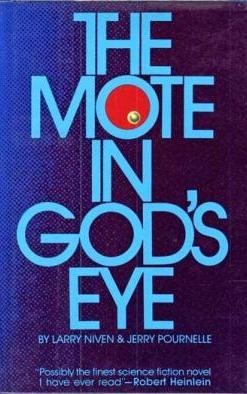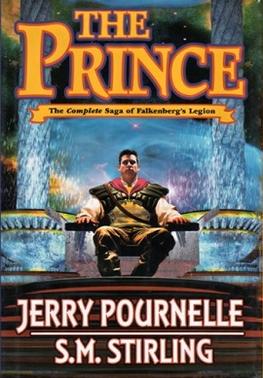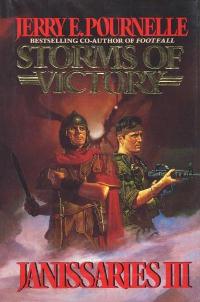Related Research Articles
The Fermi paradox is the discrepancy between the lack of conclusive evidence of advanced extraterrestrial life and the apparently high likelihood of its existence. As a 2015 article put it, "If life is so easy, someone from somewhere must have come calling by now."

Jerry Eugene Pournelle was an American scientist in the area of operations research and human factors research, a science fiction writer, essayist, journalist, and one of the first bloggers. In the 1960s and early 1970s, he worked in the aerospace industry, but eventually focused on his writing career. In an obituary in Gizmodo, he is described as "a tireless ambassador for the future."
Galactic empires are a common trope used in science fantasy and science fiction, particularly in works known as 'space operas'. Many authors have either used a galaxy-spanning empire as background or written about the growth and/or decline of such an empire. The capital of a galactic empire is frequently a core world, such as a planet relatively close to a galaxy's supermassive black hole, which has advanced considerably in science and technology compared to current human civilization. Characterizations can vary wildly from malevolent forces attacking sympathetic victims to apathetic bureaucracies to more reasonable entities focused on social progress and anywhere in between.

Military science fiction is a subgenre of science fiction that depicts the use of science fiction technology, including spaceships and weapons, for military purposes and usually principal characters who are members of a military organization, usually during a war; occurring sometimes in outer space or on a different planet or planets. It exists in a range of media, including literature, comics, film, television and video games.
CoDominium is a series of future history novels written by American writer Jerry Pournelle, along with several co-authors, primarily Larry Niven.

The Mote in God's Eye is a science fiction novel by American writers Larry Niven and Jerry Pournelle, first published in 1974. The story is set in the distant future of Pournelle's CoDominium universe, and charts the first contact between humanity and an alien species. The title of the novel is a reference to the Biblical "The Mote and the Beam" parable and is the nickname of a star. The Mote in God's Eye was nominated for the Hugo, Nebula and Locus Awards in 1975.

The Gripping Hand is a science fiction novel by American writers Larry Niven and Jerry Pournelle, published in 1993. A sequel to their 1974 work The Mote in God's Eye, The Gripping Hand is, chronologically, the last novel to be set in the CoDominium universe. In the United Kingdom, it was released as The Moat around Murcheson's Eye.

Footfall is a 1985 science fiction novel by American writers Larry Niven and Jerry Pournelle. The book depicts the arrival of members of an alien species called the Fithp that have traveled to the Solar System from Alpha Centauri in a large spacecraft driven by a Bussard ramjet. Their intent is conquest of the planet Earth.

The Reality Dysfunction is a science fiction novel by British writer Peter F. Hamilton, the first book in The Night's Dawn Trilogy. It is followed by The Neutronium Alchemist and The Naked God. It was first published in the United Kingdom by Macmillan Publishers on 26 January 1996. The first US edition, which was broken into two volumes, Emergence and Expansion, followed in July and August 1997 from Time Warner Books. The second US edition, published by Orbit Books in October 2008, is published in a single volume.

Anacreon: Reconstruction 4021 is a video game written by George Moromisato for MS-DOS and published by Thinking Machine Associates in 1987. Anacreon is a turn-based game in which human and computer players explore the galaxy, conquering worlds and putting them to use to fuel their war machines. it resembles Stellar Conquest and Hamurabi. It was inspired by Isaac Asimov's Foundation series of novels.

First contact is a common science fiction theme about the first meeting between humans and extraterrestrial life, or of any sentient species' first encounter with another one, given they are from different planets or natural satellites. The theme allows writers to explore such topics such as xenophobia, transcendentalism, and basic linguistics by adapting the anthropological topic of first contact to extraterrestrial cultures.

The Prince is a science fiction compilation by Jerry Pournelle and S. M. Stirling. It is part of the CoDominium future history series. The Prince is a compilation of four previously published novels: Falkenberg's Legion, Prince of Mercenaries, Go Tell The Spartans, and Prince of Sparta. Of the original novels, the first two were written by Pournelle alone; the last two were cowritten with Stirling. Pages 174–176 of the printed edition are new to the compilation. The Prince was published by Baen Books in hardcover (ISBN 0-7434-3556-7) in September 2002.
A kinetic bombardment or a kinetic orbital strike is the hypothetical act of attacking a planetary surface with an inert kinetic projectile from orbit, where the destructive power comes from the kinetic energy of the projectile impacting at very high speeds. The concept originated during the Cold War.

High Justice is a 1974 collection of science fiction short stories by American writer Jerry Pournelle. It was republished in an omnibus edition with Exiles to Glory in 2009 as Exile—and Glory.

Janissaries is a science fiction novel by American author Jerry Pournelle. Originally published in 1979, and illustrated by comic artist Luis Bermejo, it is the first book of Pournelle's Janissaries series. The following books are Janissaries: Clan and Crown, Janissaries III: Storms of Victory and Janissaries IV: Mamelukes.

Janissaries: Clan and Crown is a science fiction novel by American writers Jerry Pournelle and Roland J. Green, the second book of Pournelle's Janissaries series. It was originally published in 1982 and, like the first book in the series, was illustrated, this time by Josep M. Martin Sauri. In 1996 Janissaries: Clan and Crown appeared in a double novel with the third book in the Janissaries series, Janissaries III: Storms of Victory as Tran.

Janissaries III: Storms of Victory is a science fiction novel by American writers Jerry Pournelle and Roland J. Green, the third book of Pournelle's Janissaries series. It was originally published in 1987 and, unlike the first two books in the series, was not illustrated. In 1996 Janissaries III: Storms of Victory appeared in a double novel with the second book in the Janissaries series, Janissaries: Clan and Crown as Tran.

The Line of Polity is a 2003 science fiction novel by Neal Asher. It is the second novel in the Gridlinked sequence. In this novel, Earth Central Security (ECS) agent Ian Cormac is placed at the center of a civil war on the planet Masada, where an elite Theocracy lives in cylindric habitats in orbit and violently rules over commoners enslaved to laborious agriculture jobs on the planet's surface. To complicate matters, someone has attacked a low-grav Outlinker habitat with a nanomycelium which bears a striking resemblance to that used by Dragon on Samarkand in the previous novel Gridlinked. Meanwhile, a brilliant Separatist biophysicist has apparently reactivated an extremely ancient relic of technology created by the Jain, an alien species that dropped out of the universe millions of years ago, and commanded forms of technology that the brightest AI minds of the Polity have difficulty comprehending.
This is the complete list of works by American science fiction author S. M. Stirling.
References
- ↑ "Re: Starswarm". Chaos Manor . January 13, 1999.
- ↑ "Chaos Manor Reports". Chaos Manor. April 5, 2007.
- ↑ "Dancing as fast as I can". Chaos Manor. December 9, 2011. Archived from the original on January 27, 2013.
- ↑ "TWIT, Rule of Law, and Democracy; Working on Mamelukes". Chaos Manor. July 29, 2014. Archived from the original on August 8, 2014.
- ↑ "Chaos Manor Special Reports: The Mamelukes". Chaos Manor. October 7, 2006.
- ↑ "Announcing New Books from Jerry Pournelle". Chaos Manor. November 15, 2019.